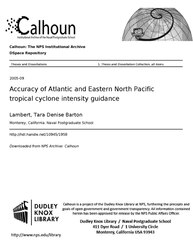File:Accuracy of Atlantic and Eastern North Pacific tropical cyclone intensity guidance (IA accuracyofatlant109451958).pdf

Original file (1,275 × 1,650 pixels, file size: 694 KB, MIME type: application/pdf, 142 pages)
Captions
Captions
Summary[edit]
| Accuracy of Atlantic and Eastern North Pacific tropical cyclone intensity guidance
( |
||
|---|---|---|
| Author |
Lambert, Tara Denise Barton |
|
| Title |
Accuracy of Atlantic and Eastern North Pacific tropical cyclone intensity guidance |
|
| Publisher |
Monterey, California. Naval Postgraduate School |
|
| Description |
Five statistical and dynamical tropical cyclone intensity guidance techniques available at the National Hurricane Center during the 2003 and 2004 Atlantic and Eastern North Pacific seasons were evaluated within three intensity phases: (I) formation; (II early intensification; and (III) decay. During the formation phase, the Decay Statistical Hurricane Intensity Prediction (DSHIPS) technique was the best technique in both basins. When the forecast errors during formation exceed +/- 10 kt, the statistical techniques tend to over-forecast and the dynamical models tend to under-forecast. Whereas DSHIPS was also the best technique in the Atlantic during the early intensification stage, the Geophysical Fluid Dynamics Laboratory model was the best in the Eastern North Pacific. All techniques under-forecast periods of rapid intensification and the peak intensity, and have an overall poor performance during decay-reintensification cycles in both basins. Whereas the DSHIPS was the best technique in the Atlantic during decay, none of the techniques excelled during the decay phase in the eastern North Pacific. All techniques tend to decay the tropical cyclones in both basins too slowly, except that the DSHIPS performed well (13 of 15) during rapid decay events in the Atlantic. Similar error characteristics had been found in the western North Pacific. Subjects: Weather forecasting; Cyclones; Tropics; Hurricanes; Meteorology; Oceanography |
|
| Language | English | |
| Publication date | September 2005 | |
| Current location |
IA Collections: navalpostgraduateschoollibrary; fedlink |
|
| Accession number |
accuracyofatlant109451958 |
|
| Source | ||
| Permission (Reusing this file) |
Approved for public release, distribution unlimited | |
Licensing[edit]
| Public domainPublic domainfalsefalse |
This work is in the public domain in the United States because it is a work prepared by an officer or employee of the United States Government as part of that person’s official duties under the terms of Title 17, Chapter 1, Section 105 of the US Code.
Note: This only applies to original works of the Federal Government and not to the work of any individual U.S. state, territory, commonwealth, county, municipality, or any other subdivision. This template also does not apply to postage stamp designs published by the United States Postal Service since 1978. (See § 313.6(C)(1) of Compendium of U.S. Copyright Office Practices). It also does not apply to certain US coins; see The US Mint Terms of Use.
|
 | |
| This file has been identified as being free of known restrictions under copyright law, including all related and neighboring rights. | ||
https://creativecommons.org/publicdomain/mark/1.0/PDMCreative Commons Public Domain Mark 1.0falsefalse
File history
Click on a date/time to view the file as it appeared at that time.
| Date/Time | Thumbnail | Dimensions | User | Comment | |
|---|---|---|---|---|---|
| current | 20:43, 13 July 2020 |  | 1,275 × 1,650, 142 pages (694 KB) | Fæ (talk | contribs) | FEDLINK - United States Federal Collection accuracyofatlant109451958 (User talk:Fæ/IA books#Fork8) (batch 1993-2020 #5112) |
You cannot overwrite this file.
File usage on Commons
The following page uses this file:
Metadata
This file contains additional information such as Exif metadata which may have been added by the digital camera, scanner, or software program used to create or digitize it. If the file has been modified from its original state, some details such as the timestamp may not fully reflect those of the original file. The timestamp is only as accurate as the clock in the camera, and it may be completely wrong.
| Author | tdlamber |
|---|---|
| Short title |
|
| Date and time of digitizing | 19:54, 28 September 2005 |
| File change date and time | 06:38, 28 September 2005 |
| Date metadata was last modified | 06:38, 28 September 2005 |
| Software used | PScript5.dll Version 5.2.2 |
| Conversion program | Acrobat Distiller 5.0.5 (Windows) |
| Encrypted | no |
| Page size | 612 x 792 pts (letter) |
| Version of PDF format | 1.4 |

